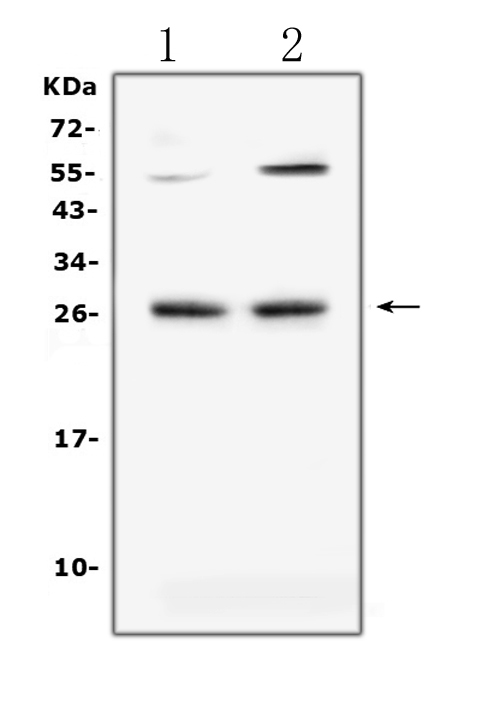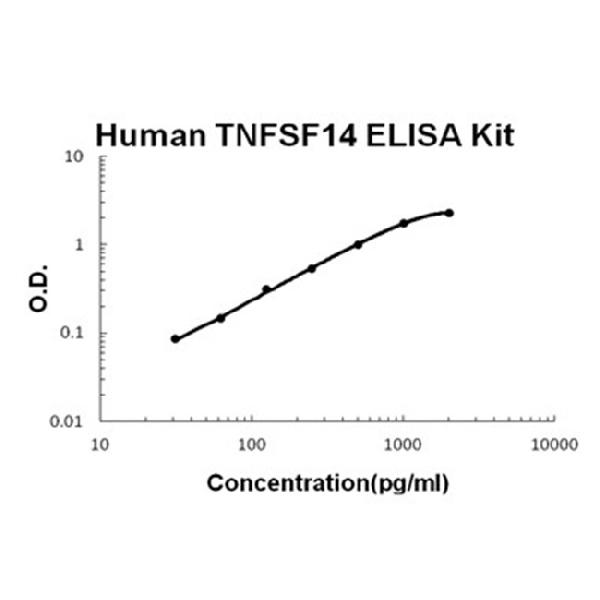Product Info Summary
| SKU: | A03516-1 |
|---|---|
| Size: | 100 μg/vial |
| Reactive Species: | Mouse, Rat |
| Host: | Rabbit |
| Application: | ELISA, WB |
Customers Who Bought This Also Bought
Product info
Product Name
Anti-LIGHT/Tnfsf14 Antibody Picoband™
View all LIGHT/TNFSF14 Antibodies
SKU/Catalog Number
A03516-1
Size
100 μg/vial
Form
Lyophilized
Description
Boster Bio Anti-LIGHT/Tnfsf14 Antibody Picoband™ catalog # A03516-1. Tested in ELISA, WB applications. This antibody reacts with Mouse, Rat.
Storage & Handling
Store at -20˚C for one year from date of receipt. After reconstitution, at 4˚C for one month. It can also be aliquotted and stored frozen at -20˚C for six months. Avoid repeated freeze-thaw cycles.
Cite This Product
Anti-LIGHT/Tnfsf14 Antibody Picoband™ (Boster Biological Technology, Pleasanton CA, USA, Catalog # A03516-1)
Host
Rabbit
Contents
Each vial contains 4mg Trehalose, 0.9mg NaCl, 0.2mg Na2HPO4, 0.05mg NaN3.
Clonality
Polyclonal
Isotype
Rabbit IgG
Immunogen
E. coli-derived mouse LIGHT recombinant protein (Position: L59-V239).
*Blocking peptide can be purchased. Costs vary based on immunogen length. Contact us for pricing.
Cross-reactivity
No cross-reactivity with other proteins.
Reactive Species
A03516-1 is reactive to TNFSF14 in Mouse, Rat
Applications
A03516-1 is guaranteed for ELISA, WB Boster Guarantee
Observed Molecular Weight
26 kDa
Calculated molecular weight
26.35kDa
Background of LIGHT/TNFSF14
Tumor necrosis factor ligand superfamily member 14 is a protein that in humans is encoded by the TNFSF14 gene. TNFSF14 has also been designated as CD258, as well as LIGHT. It was mapped on chromosome 19p13.3. The protein encoded by this gene is a member of the tumor necrosis factor (TNF) ligand family. This protein may function as a costimulatory factor for the activation of lymphoid cells and as a deterrent to infection by herpesvirus. It has been shown to stimulate the proliferation of T cells, and trigger apoptosis of various tumor cells. This protein is also reported to prevent tumor necrosis factor alpha mediated apoptosis in primary hepatocyte. Two alternatively spliced transcript variant encoding distinct isoforms have been reported.
Antibody Validation
Boster validates all antibodies on WB, IHC, ICC, Immunofluorescence, and ELISA with known positive control and negative samples to ensure specificity and high affinity, including thorough antibody incubations.
Innovating Scientists Reward
If you are the first to review this product, or if you have results for a special sample, species or application this product is not validated in, share your results with us and receive product credits you can use towards any Boster products! Applicable to all scientists worldwide.
Submit A Review
Assay dilution & Images
Reconsitution
Add 0.2ml of distilled water will yield a concentration of 500ug/ml.
Assay Dilutions Recommendation
The recommendations below provide a starting point for assay optimization. The actual working concentration varies and should be decided by the user.
Western blot, 0.1-0.5μg/ml
Direct ELISA, 0.1-0.5μg/ml
Validation Images & Assay Conditions

Click image to see more details
Figure 1. Western blot analysis of LIGHT using anti-LIGHT antibody (A03516-1).
Electrophoresis was performed on a 5-20% SDS-PAGE gel at 70V (Stacking gel) / 90V (Resolving gel) for 2-3 hours. The sample well of each lane was loaded with 50ug of sample under reducing conditions.
Lane 1: mouse spleen tissue lysates,
Lane 2: mouse cardiac muscle tissue lysates.
After Electrophoresis, proteins were transferred to a Nitrocellulose membrane at 150mA for 50-90 minutes. Blocked the membrane with 5% Non-fat Milk/ TBS for 1.5 hour at RT. The membrane was incubated with rabbit anti-LIGHT antigen affinity purified polyclonal antibody (Catalog # A03516-1) at 0.5 ug/mL overnight at 4 then washed with TBS-0.1%Tween 3 times with 5 minutes each and probed with a goat anti-rabbit IgG-HRP secondary antibody at a dilution of 1:10000 for 1.5 hour at RT. The signal is developed using an Enhanced Chemiluminescent detection (ECL) kit (Catalog # EK1002) with Tanon 5200 system. A specific band was detected for LIGHT at approximately 26KD. The expected band size for LIGHT is at 26KD.
Protein Target Info & Infographic
Gene/Protein Information For TNFSF14 (Source: Uniprot.org, NCBI)
Gene Name
TNFSF14
Full Name
Tumor necrosis factor ligand superfamily member 14
Weight
26.35kDa
Superfamily
tumor necrosis factor family
Alternative Names
CD258 antigen; CD258; delta transmembrane LIGHT; Herpes virus entry mediator ligand; Herpesvirus entry mediator ligand; HVEM-L; HVEMLherpesvirus entry mediator-ligand; ligand for herpesvirus entry mediator; LIGHT; LIGHTherpesvirus entry mediator A; LTg; TNFSF14; TR2; tumor necrosis factor (ligand) superfamily, member 14; tumor necrosis factor ligand superfamily member 14; tumor necrosis factor receptor-like 2; tumor necrosis factor superfamily member LIGHT TNFSF14 CD258, HVEML, LIGHT, LTg TNF superfamily member 14 tumor necrosis factor ligand superfamily member 14|herpesvirus entry mediator ligand|tumor necrosis factor (ligand) superfamily, member 14|tumor necrosis factor ligand 1D|tumor necrosis factor superfamily member 14
*If product is indicated to react with multiple species, protein info is based on the gene entry specified above in "Species".For more info on TNFSF14, check out the TNFSF14 Infographic

We have 30,000+ of these available, one for each gene! Check them out.
In this infographic, you will see the following information for TNFSF14: database IDs, superfamily, protein function, synonyms, molecular weight, chromosomal locations, tissues of expression, subcellular locations, post-translational modifications, and related diseases, research areas & pathways. If you want to see more information included, or would like to contribute to it and be acknowledged, please contact [email protected].
Specific Publications For Anti-LIGHT/Tnfsf14 Antibody Picoband™ (A03516-1)
Hello CJ!
No publications found for A03516-1
*Do you have publications using this product? Share with us and receive a reward. Ask us for more details.
Recommended Resources
Here are featured tools and databases that you might find useful.
- Boster's Pathways Library
- Protein Databases
- Bioscience Research Protocol Resources
- Data Processing & Analysis Software
- Photo Editing Software
- Scientific Literature Resources
- Research Paper Management Tools
- Molecular Biology Software
- Primer Design Tools
- Bioinformatics Tools
- Phylogenetic Tree Analysis
Customer Reviews
Have you used Anti-LIGHT/Tnfsf14 Antibody Picoband™?
Submit a review and receive an Amazon gift card.
- $30 for a review with an image
Be the first to review Anti-LIGHT/Tnfsf14 Antibody Picoband™
*The first user to submit a review for a product is eligible for Boster's Innovating Scientists Reward, which gives product credits. This is in addition to the gift card reward.
Customer Q&As
Have a question?
Find answers in Q&As, reviews.
Can't find your answer?
Submit your question
5 Customer Q&As for Anti-LIGHT/Tnfsf14 Antibody Picoband™
Question
Does A03516-1 anti-LIGHT/Tnfsf14 antibody work on parafin embedded sections? If so, which fixation method do you recommend we use (PFA, paraformaldehyde, other)?
Verified Customer
Verified customer
Asked: 2019-09-05
Answer
You can see on the product datasheet, A03516-1 anti-LIGHT/Tnfsf14 antibody as been validated on ELISA. It is best to use PFA for fixation because it has better tissue penetration ability. PFA needs to be prepared fresh before use. Long term stored PFA turns into formalin, as the PFA molecules congregate and become formalin.
Boster Scientific Support
Answered: 2019-09-05
Question
I see that the anti-LIGHT/Tnfsf14 antibody A03516-1 works with ELISA, what is the protocol used to produce the result images on the product page?
Verified Customer
Verified customer
Asked: 2019-08-16
Answer
You can find protocols for ELISA on the "support/technical resources" section of our navigation menu. If you have any further questions, please send an email to [email protected]
Boster Scientific Support
Answered: 2019-08-16
Question
Is a blocking peptide available for product anti-LIGHT/Tnfsf14 antibody (A03516-1)?
Verified Customer
Verified customer
Asked: 2017-12-04
Answer
We do provide the blocking peptide for product anti-LIGHT/Tnfsf14 antibody (A03516-1). If you would like to place an order for it please contact [email protected] and make a special request.
Boster Scientific Support
Answered: 2017-12-04
Question
We are currently using anti-LIGHT/Tnfsf14 antibody A03516-1 for mouse tissue, and we are happy with the ELISA results. The species of reactivity given in the datasheet says mouse, rat. Is it likely that the antibody can work on goat tissues as well?
Verified Customer
Verified customer
Asked: 2017-11-02
Answer
The anti-LIGHT/Tnfsf14 antibody (A03516-1) has not been validated for cross reactivity specifically with goat tissues, though there is a good chance of cross reactivity. We have an innovator award program that if you test this antibody and show it works in goat you can get your next antibody for free. Please contact me if I can help you with anything.
Boster Scientific Support
Answered: 2017-11-02
Question
Will anti-LIGHT/Tnfsf14 antibody A03516-1 work on monkey ELISA with right lobe of liver?
A. Thomas
Verified customer
Asked: 2017-11-02
Answer
Our lab technicians have not tested anti-LIGHT/Tnfsf14 antibody A03516-1 on monkey. You can run a BLAST between monkey and the immunogen sequence of anti-LIGHT/Tnfsf14 antibody A03516-1 to see if they may cross-react. If the sequence homology is close, then you can perform a pilot test. Keep in mind that since we have not validated monkey samples, this use of the antibody is not covered by our guarantee. However we have an innovator award program that if you test this antibody and show it works in monkey right lobe of liver in ELISA, you can get your next antibody for free.
Boster Scientific Support
Answered: 2017-11-02





